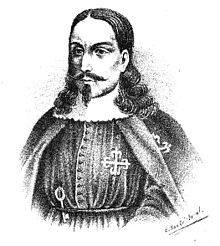| DonPedro Álvarez de ToledoMarqués de Mancera Caballero de Alcántara | |
|---|---|
 Portrait by Evaristo San Cristóval Portrait by Evaristo San Cristóval | |
| 15th Viceroy of Peru | |
| In office December 18, 1639 – September 20, 1648 | |
| Monarch | Philip IV |
| Prime Minister | Count-Duke of Olivares |
| Preceded by | The Count of Chinchón |
| Succeeded by | The Count of Salvatierra |
| Personal details | |
| Born | c.1585 Madrid, Spain |
| Died | March 9, 1654(1654-03-09) (aged 68–69) Madrid, Spain |
| Spouse(s) | Luisa Feijóo de Novoa María Luisa de Salazar |
| Children | Francisca, Antonio, Antonia |
| Profession | Lieutenant General |
| Signature |  |
Pedro Álvarez de Toledo y Leiva, 1st Marquis of Mancera (c. 1585–1654), was a Spanish nobleman, general, colonial administrator, and diplomat. He served as Captain General of Galicia and Viceroy of Peru from December 18, 1639 to September 20, 1648.
Early life
Pedro de Toledo was the son of Don Luis de Toledo, 4th Lord of Mancera, and of his second wife Isabel de Leiva. He served with the Spanish armies in Italy, rising to the rank of lieutenant general in the royal galleys of Sicily.
King Philip IV of Spain raised his title from Lord to Marquis of Mancera in 1623. Thereafter he served eight years as governor and Captain General of Galicia.
Viceroy of Peru
Pedro de Toledo was named the 15th Viceroy of Peru in 1639, at the age of 54. He traveled to the Viceroyalty of Peru with his son Antonio Sebastián de Toledo, who later became the Viceroy of New Spain (1664–73) and 2nd Marquis of Mancera.
As viceroy, Pedro de Toledo introduced the papel sellado (literally, sealed paper). He expanded the naval forces and fortified the ports of Valdivia, Valparaíso, Arica and Callao. In Callao he ordered the construction of a 4 kilometres (2.5 mi) long defensive wall, which was completed in 1647. Isla Mancera, an island at the mouth of the Valdivia River, is named after him.
He organized literary discussion parties, tertulias a formalized kind of official salon. In these was introduced the mancerina, a ceramic or silver saucer with a framework for holding a jícara, or chocolate cup. The manufacture of mancerinas later became an industry in the Spanish towns of Manises and Talavera.
At the end of his term as viceroy, Pedro de Toledo returned to Spain. He died in Madrid in 1654.
Descendants
Pedro de Toledo was married first to Luisa Feijóo de Novoa y Zamudio, with whom he had one daughter. In 1621 he married for a second time with María Luisa de Salazar y Enríquez de Navarra, 3rd Lady of El Mármol, with whom he had another two children.
By Luisa Feijóo de Novoa:
- Francisca María de Toledo, 2nd Marchioness of Belvis, married Diego Sarmiento de Acuña, 2nd Count of Gondomar
By María Luisa de Salazar:
- Antonio Sebastián Álvarez de Toledo, 2nd Marquis of Mancera
- Antonia María de Toledo, married Pedro Garcés, 14th Count of Priego
Ancestry
| 8. Pedro de Toledo 1st Lord of Mancera | |||||||||||||||
| 4. Enrique de Toledo 3rd Lord of Mancera | |||||||||||||||
| 9. Leonor de Ayala | |||||||||||||||
| 2. Luis de Toledo 4th Lord of Mancera | |||||||||||||||
| 10. Diego de Castilla 3rd Lord of Gor | |||||||||||||||
| 5. Isabel de Mendoza | |||||||||||||||
| 11. Beatriz de Mendoza | |||||||||||||||
| 1. Pedro Álvarez de Toledo | |||||||||||||||
| 12. Sancho Martínez Lord of the house of Leiva | |||||||||||||||
| 6. Sancho Martínez de Leiva Lord of the house of Leiva | |||||||||||||||
| 13. Francisca Ladrón de Guevara | |||||||||||||||
| 3. Isabel de Leiva | |||||||||||||||
| 14. Garcí II Hurtado de Mendoza 8th Lord of la Corzana | |||||||||||||||
| 7. Leonor de Mendoza | |||||||||||||||
| 15. Ana de Leiva | |||||||||||||||
Additional information
Notes
- in full, Spanish: Don Pedro Álvarez de Toledo y Leiva, sexto señor y primer Marqués de Mancera, Virrey de Galicia y del Perú, embajador en Alemania y Venecia, del Consejo de Guerra de Don Felipe II, caballero de la orden de Alcalá y comendador de Esparragosa)
- Papel sellado (literally, sealed paper): A series of measures were adopted for the purpose of increasing royal revenues in the first part of the seventeenth century. One of the measures was the introduction of papel sellado, by a royal decree of 1638. This required the use of seals on official documents in the Indies, such as contracts, judicial decrees, and deeds. A tax was charged for the seals.
- See zarf.
Sources
- Castro Pereira Mouzinho de Albuquerque e Cunha, Fernando de (1995). Instrumentário Genealógico - Linhagens Milenárias (in Portuguese). pp. 329–30.
- Hobbs, Nicolas (2007). "Grandes de España" (in Spanish). Archived from the original on October 25, 2008. Retrieved 15 October 2008.
- Instituto de Salazar y Castro. Elenco de Grandezas y Titulos Nobiliarios Españoles (in Spanish). periodic publication.
External links
- (in Spanish) Short biography from Encarta
- (in Spanish)—Usuarios.lycos.es: information about marriage of Pedro de Toledo
- (in Spanish)—Agn.gob.mx: Papel sellado
- Gourmetsleuth.com: Mancerinas —information + photos.
| Government offices | ||
|---|---|---|
| Preceded byThe Count of Chinchón | Viceroy of Peru 1639–1648 |
Succeeded byThe Count of Salvatierra |
| Spanish nobility | ||
| New title | Marquis of Mancera 1623–1654 |
Succeeded byAntonio Sebastián de Toledo |